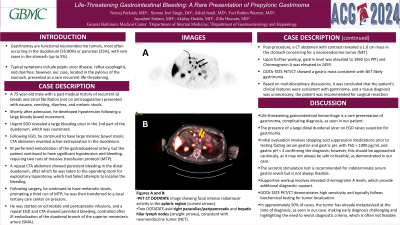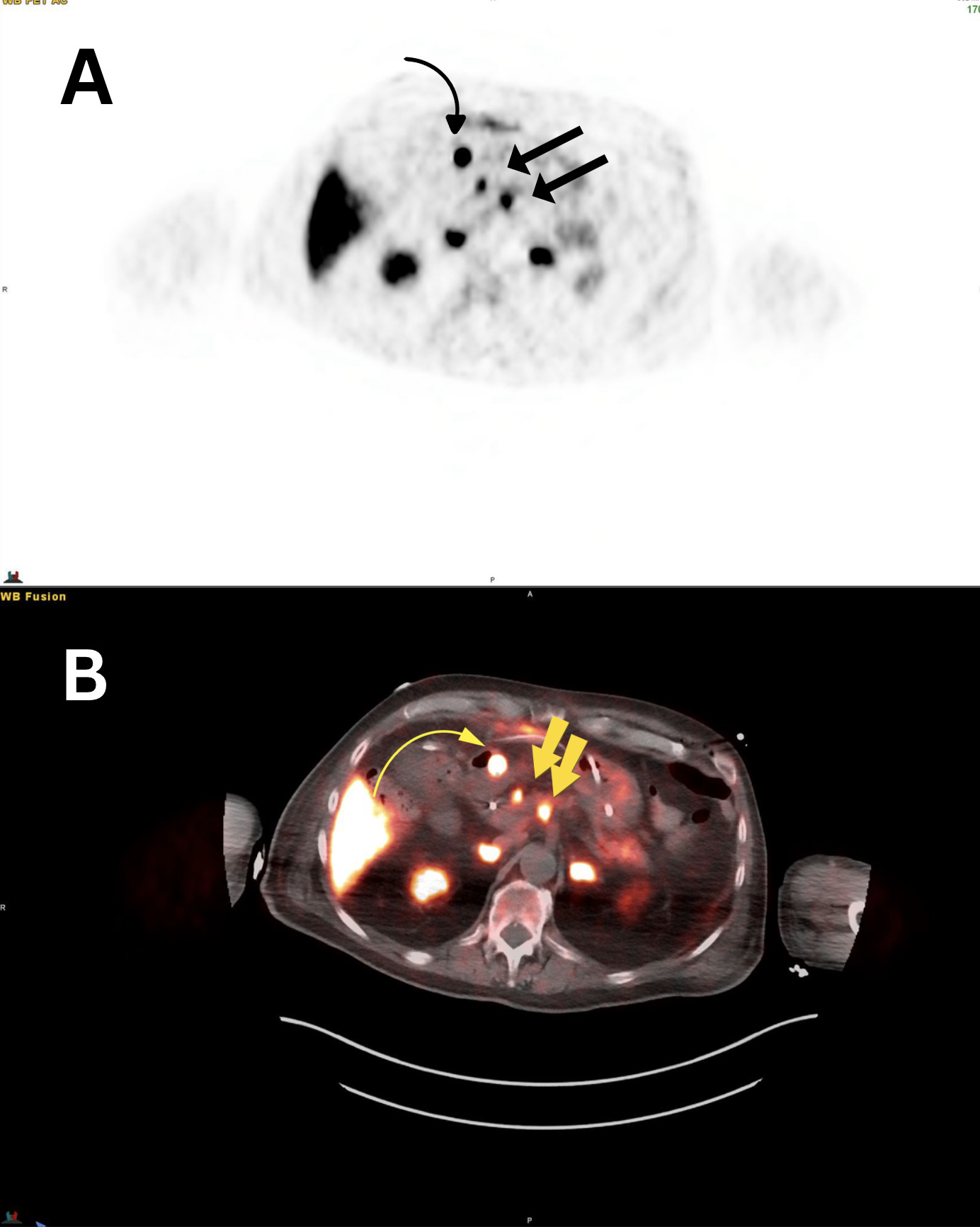Tuesday Poster Session
Category: GI Bleeding
P4217 - Life-Threatening Gastrointestinal Bleeding: A Rare Presentation of Prepyloric Gastrinoma
Tuesday, October 29, 2024
10:30 AM - 4:00 PM ET
Location: Exhibit Hall E

Has Audio

Neeraj Parkash, MD
Greater Baltimore Medical Center
Baltimore, MD
Presenting Author(s)
Neeraj Parkash, MD, Simran Jeet Singh, DO, Zahid Jamil, MD, Fazl Rahim Wazeen, MD, Jayashrei Sairam, MD, Akshay Duddu, MD, Zilla Hussain, MD
Greater Baltimore Medical Center, Towson, MD
Introduction: Gastrinomas are functional neuroendocrine tumors characterized by the hypersecretion of gastrin. Majority of the cases occur in the duodenum (55-80%), followed by the pancreas (25%) and rarely within the stomach, constituting only up to 5% of all cases. Common symptoms include PUD, reflux esophagitis, and diarrhea. Rarely, it can present as recurrent life-threatening gastrointestinal hemorrhage, as in our case.
Case Description/Methods: A 75-year-old male with past medical history of recurrent GI bleeds, and a fib not on AC, presented with nausea, vomiting, diarrhea and melanic stools. Shortly after admission, he developed hypotension after a large bloody bowel movement. Urgent EGD revealed a large bleeding ulcer in the 2nd part of the duodenum, that was cauterized. Following EGD, he continued to have large melanic bowel stools and CTA abdomen revealed active extravasation in the duodenum. IR performed embolization of the gastroduodenal artery, but he continued to have significant hypotension, requiring 2 runs of massive transfusion protocol (MTP). A repeat CTA abdomen showed persistent bleeding in the distal duodenum, after which he was taken to the OR for exploratory laparotomy, with failed attempts to localize the bleeding. Following surgery, a third run of MTP was initiated and was transferred to a local tertiary care center on pressors. He was then started on octreotide and pantoprazole infusions, and a repeat EGD and CTA showed persistent bleeding which was controlled after IR embolization of duodenal branch of SMA. CT abdomen with contrast revealed 1.6 cm mass in stomach concerning for NET. Upon further work up, Gastrin level was elevated to 1992 on PPI, Chromogranin A was elevated to 2459. DOTA-TATE PET/CT showed a gastric mass consistent with NET likely Gastrinoma. Based on multidisciplinary discussions; it was concluded that tissue diagnosis was't required and patient was recommended for surgical resection.
Discussion: Life threatening Gastrointestinal hemorrhage is a rare presentation of Gastrinoma making diagnosis a challenging one as in our patient. Evaluation includes up to 10 folds increase in serum gastrin and < 2 gastric pH. Secretin stimulation test is recommended in case of indeterminate serum Gastrin levels but is not always feasible. Elevated chromogranin A levels are supportive. DOTA-TATE PET/CT has high sensitivity and usually follows biochemical testing for localization of the tumor.

Disclosures:
Neeraj Parkash, MD, Simran Jeet Singh, DO, Zahid Jamil, MD, Fazl Rahim Wazeen, MD, Jayashrei Sairam, MD, Akshay Duddu, MD, Zilla Hussain, MD. P4217 - Life-Threatening Gastrointestinal Bleeding: A Rare Presentation of Prepyloric Gastrinoma, ACG 2024 Annual Scientific Meeting Abstracts. Philadelphia, PA: American College of Gastroenterology.
Greater Baltimore Medical Center, Towson, MD
Introduction: Gastrinomas are functional neuroendocrine tumors characterized by the hypersecretion of gastrin. Majority of the cases occur in the duodenum (55-80%), followed by the pancreas (25%) and rarely within the stomach, constituting only up to 5% of all cases. Common symptoms include PUD, reflux esophagitis, and diarrhea. Rarely, it can present as recurrent life-threatening gastrointestinal hemorrhage, as in our case.
Case Description/Methods: A 75-year-old male with past medical history of recurrent GI bleeds, and a fib not on AC, presented with nausea, vomiting, diarrhea and melanic stools. Shortly after admission, he developed hypotension after a large bloody bowel movement. Urgent EGD revealed a large bleeding ulcer in the 2nd part of the duodenum, that was cauterized. Following EGD, he continued to have large melanic bowel stools and CTA abdomen revealed active extravasation in the duodenum. IR performed embolization of the gastroduodenal artery, but he continued to have significant hypotension, requiring 2 runs of massive transfusion protocol (MTP). A repeat CTA abdomen showed persistent bleeding in the distal duodenum, after which he was taken to the OR for exploratory laparotomy, with failed attempts to localize the bleeding. Following surgery, a third run of MTP was initiated and was transferred to a local tertiary care center on pressors. He was then started on octreotide and pantoprazole infusions, and a repeat EGD and CTA showed persistent bleeding which was controlled after IR embolization of duodenal branch of SMA. CT abdomen with contrast revealed 1.6 cm mass in stomach concerning for NET. Upon further work up, Gastrin level was elevated to 1992 on PPI, Chromogranin A was elevated to 2459. DOTA-TATE PET/CT showed a gastric mass consistent with NET likely Gastrinoma. Based on multidisciplinary discussions; it was concluded that tissue diagnosis was't required and patient was recommended for surgical resection.
Discussion: Life threatening Gastrointestinal hemorrhage is a rare presentation of Gastrinoma making diagnosis a challenging one as in our patient. Evaluation includes up to 10 folds increase in serum gastrin and < 2 gastric pH. Secretin stimulation test is recommended in case of indeterminate serum Gastrin levels but is not always feasible. Elevated chromogranin A levels are supportive. DOTA-TATE PET/CT has high sensitivity and usually follows biochemical testing for localization of the tumor.

Figure: A and B: PET CT DOTATATE image showing focal intense radiotracer activity in the pyloric region(curved arrows) and Two Dotatate-avid right paraceliac/peripancreatic and hepatic hilar lymph nodes(straight arrows) consistent with NET.
Disclosures:
Neeraj Parkash indicated no relevant financial relationships.
Simran Jeet Singh indicated no relevant financial relationships.
Zahid Jamil indicated no relevant financial relationships.
Fazl Rahim Wazeen indicated no relevant financial relationships.
Jayashrei Sairam indicated no relevant financial relationships.
Akshay Duddu indicated no relevant financial relationships.
Zilla Hussain indicated no relevant financial relationships.
Neeraj Parkash, MD, Simran Jeet Singh, DO, Zahid Jamil, MD, Fazl Rahim Wazeen, MD, Jayashrei Sairam, MD, Akshay Duddu, MD, Zilla Hussain, MD. P4217 - Life-Threatening Gastrointestinal Bleeding: A Rare Presentation of Prepyloric Gastrinoma, ACG 2024 Annual Scientific Meeting Abstracts. Philadelphia, PA: American College of Gastroenterology.
